In poetry, there are three units of architecture, or structure: words, lines, and stanzas. As with all forms of writing, words comprise the most basic level of form. But what makes poetry unique as a genre is verse—lines—which work as both a unit of sensibility and music. Lines assemble into stanzas, or “rooms” in Italian. Sometimes poems can have sections, too, where stanzas are confined yet relate to one another, and sometimes poems can break from line and stanza into what we call prose poems, which we will discuss later.
The Line: Rows
Originally, poetry was used as a way to remember stories, which were delivered orally by a speaker or “the poet” to an audience. The units created verse, which in Latin translates to “line,” “row,” or “furrow,” musical measures that were easier to remember. Poetry existed before writing; and even after writing was invented most people could not read. Poetry has been a way throughout human existence for people to pass on history, news, entertainment, and wisdom from one generation to the next. With the spread of literacy, the function of lines began to take on more complexity, increasing auditory and visual impacts. By the twentieth century, typeface allowed poets to place visual form at the center of their art.
It is apt that “verse” translates to “row” or “furrow,” words we also use when speaking of gardens and farms (and also to the lines on our foreheads when we brood!). Think of each line of poetry you write as a row in your garden that is the poem. Every garden is different and the plants in it do not simply lie atop the surface; roots go deep and flourish from the nutrients in the soil. In a poem, those nutrients are the knowledge and emotions of the poet which, like in a garden, we do not see. Instead we see emotions and ideas transformed linguistically into imagery and music. In this analogy, words are the plants and flowers that the poet/gardener has chosen, and they are rooted into the earth, into history, into what came before.
Words cannot detach themselves from their meanings and nuances. Each is a seed fallen from a mother plant. Poetry, the garden in which generations of words may flourish, gives opportunities for words to evolve. It is why the poet is known as the “keeper of language,” giving words to the unspeakable, naming the unnameable.
In our gardens, the line is a unit of measurement different from that of sentences. A line can ignore syntax and grammar to create interesting effects. For instance, a line can end on a verb and suspend the object onto the next line. This move can increase speed, or the pace, of the poem, as the reader is propelled forward to complete the thought. The line break can also create an image or idea that can transform when the reader reaches the next line. For example, in Bruce Snider’s poem “Epitaph,” the word “alive” creates one meaning that changes with the turn to the next line:
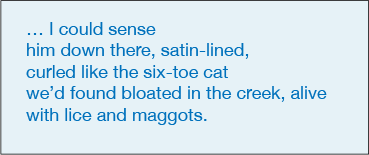
As readers we think at first that the cat is alive, only to find that it is alive but with “lice and maggots.” The effect comes from the use of an enjambed line, a line that does not end with punctuation. This enjambment is referred to as hard enjambment because it has so much of an effect and impact on the poem’s reading. Enjambed lines can suggest complex meaning, create images or emphasis, and control the music, or prosody of the poem. In contrast, when a line ends with a form of punctuation, or with a complete phrase, we refer to those lines as end-stopped.
Deciding where to break a line can be determined by a number of things: rhythm, rhyme, emphasis, pace, or the way a poem looks on a page. Classic forms predetermine the form a poem takes, and include rules concerning meter, rhyme, and repetition. Some forms like the Shakespearian sonnet include the element of a turn, or a volta, in which there is a marked change in the speaker in thought, emotion, or rhetoric. Forms are fun to experiment with and assert pressure on the writer in interesting ways that result in surprises that wouldn’t occur otherwise.
Today, a lot of poetry is written in free verse, or vers libre in Latin, not requiring the poet to follow any prescribed rules of form. Robert Frost famously referred to writing free verse as “playing tennis without a net.” And as you saw in the previous chapter, Billy Collins has noted the way free verse poems have come to rely on tone of voice to hold it together. Free verse does not mean, however, that there is no pattern of rhythm or sounds holding a poem together, necessarily; rather it means that the design of the poem is the poet’s own invention.
End-Stopped Lines and Enjambment
In the following poem, “Autumn Begins in Martins Ferry, Ohio,” James Wright keeps his lines syntactically intact and uses almost entirely end-stopped lines. Read the poem via the Poetry Foundation. https://www.poetryfoundation.org/poems/47733/autumn-begins-in-martins-ferry-ohio
The pauses at the ends of Wright’s lines are natural in speech and adhere to the formation of phrases, the units of sentences. Incorporating enjambment, Wright could’ve altered the music, meaning, and emphasis of this poem if he had started:
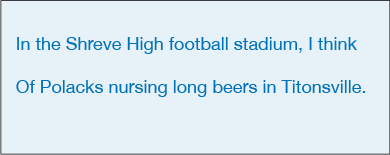
You can see in this example how the speaker’s thinking is emphasized more than in the original because now the verb, “think,” falls at the end of the line. This formation also sets up a delay for the reader to find out what the speaker is thinking about. If this were the first line of the poem, we’d initially have more of a focus on the speaker and his thinking, his brooding. Instead, the first four lines of the original end with a place—stadium, Titonsville, Benwood, and Wheeling Steel. In addition, the punctuation enforces more of a pause at the end of the line than the break already does. We sense the separation of the places, yet their connectedness through the stanza that joins them, as well as the last line of the stanza which unites the Polacks, Negroes, and watchman through an action: “dreaming of heroes.” The collective action suggests that the speaker, part of this larger community, is also dreaming of heroes.
The only line not end-stopped with punctuation in the poem happens in the last stanza: “Their sons grow suicidally beautiful,” and this difference, as any change does, makes the line stand out. Even though there’s no punctuation, this line is not forcefully enjambed, as Wright continues to adhere to syntactical units:
Possessive pronoun (Their)—noun (sons)—verb (grow)—adverb (suicidally)—adjective (beautiful)
And because he does, there is little if any jarring with the break to “At the beginning of October.”
Overall, the end-stopped lines and syntactical intactness of the lines moves the poem slowly, one step it seems at a time until it reaches its sum: “Therefore,” at which point the poem loosens its pace and speeds up just for a bit, as if the sons begin to “gallop” or run, as the line itself runs over into the next.
At the end of another one of Wright’s poems, “A Blessing,” enjambment is used to surprise the reader with an image that changes as the penultimate, or second to last, line gives way to the final line:
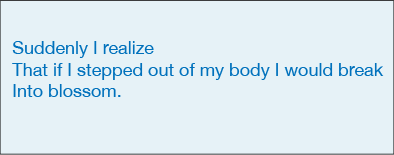
The hard enjambment between “break” and “blossom” creates an initial image of breaking in which the tone is harsh, violent, a loss, a break in need of repair. But the last line changes the tone with the image of a body breaking into blossom rather than simply breaking.
In contrast to Wright’s poem, the following poem by Aimee Nezhukumatathil employs mostly enjambed lines that ignore syntactically complete units in this poem about the explorers Meriwether Lewis and William Clark:
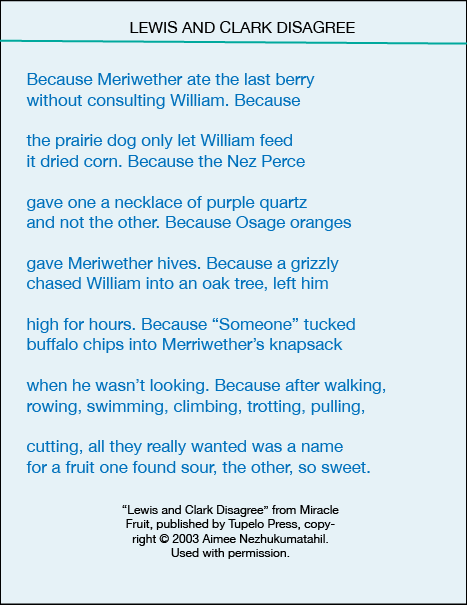
The form is almost the exact opposite of Wrights’: ten enjambed lines followed by two endstopped, then an enjambed line, then an end-stopped line. In this poem the lines break sometimes on the first word of the next sentence. If we were to layout the lines in terms of sentences, we would be left with an almost bullet-pointed list of reasons for why “Lewis and Clark Disagree” and they would look like this:
Because Meriwether ate the last berry without consulting William.
Because the prairie dog only let William feed it dried corn.
Because the Nez Perce gave one a necklace of purple quartz and not the other.
Because Osage oranges gave Meriwether hives.
Because a grizzly chased William into an oak tree, left him high for hours.
Because “Someone” tucked buffalo chips into Meriwether’s knapsack when he wasn’t looking.
Because after walking, rowing, swimming, climbing, trotting, pulling, cutting, all they really wanted was a name for a fruit one found sour, the other, so sweet.
Because, because, because, because, because. Instead, verse allows Nezhukumatathil to tone down the repetition of “Because” while also allowing her to manipulate rhythm and layer meaning. Take, for instance, the following lines:
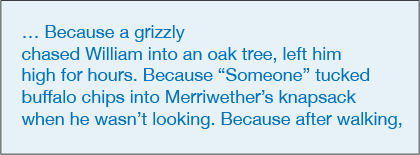
The break after “left him” allows the image and idea of abandonment to linger before its meaning evolves into the complete thought “left him high for hours.” The next two lines use the break to emphasize the alliteration of “tuck” and “-sack,” which even continues beyond that couplet to the next with “walk.” “Walk” and “Tuck” also being verbs, we are propelled forward to the next line by action. As for meaning, we come to “tuck” and think: tucked what?
With lines, generally the first and last words will take on extra emphasis, and in “Lewis and Clark Disagree” they have multiple effects. Some lines begin and end where they do to emphasize meaning: “left him” and “when he wasn’t looking” suggest tension that feeds back to the relationship between Lewis and Clark; abandonment and sneakiness aren’t marks of kindness. We read “left him” and think how terrible! We turn to “when he wasn’t looking” and think, oooooh sneaky.
Like Wright’s poem, this poem changes its pattern, moving from enjambed lines to endstopped lines. The last sentence of the poem is strung out over four lines and arranged in a way so that the acoustics develop the feel of a burden or a long list:
… Because after walking,
rowing, swimming, climbing, trotting, pulling,
cutting, all they really wanted was a name
for a fruit one found sour, the other, so sweet.
Listen to how the rising pitch in the first line gives way to a list of actions that propels us into
the penultimate line:
. . . walking, [↑]
[→] rowing, swimming, climbing, trotting, pulling, [a big pause]
There is a long pause between “pulling” and “cutting” produced from the break of momentum in the list of actions. Nezhukumatathil could’ve placed all the verbs on one line to create an entirely different feel:
walking, rowing, swimming, climbing, trotting, pulling, cutting
But instead, in order to keep the inflection and pitch varied, she rearranges words on a line differently, regardless of their syntactical relationships.
Association:
Sometimes the glue that holds a free verse poem together is the writer’s own associations and connections between ideas and imagery. Association can provide a glimpse of a mind in action, can create surprise, whimsy, and a sense of getting an “inside view” of a writer’s (or speaker’s) thought-process. If the associative leaps made in a poem are too obscure that can create a sense of distance—as being locked out of a private reference– rather than intimacy for the reader. CNM Instructor Rebecca Aronson reflects on the associative process in writing the following poem: https://plumepoetry.com/prayer-written-on-a-wide-veranda-on-a-comfortable-couch-in-sewanee-tn/
“Prayer Written on a Wide Veranda on a Comfortable Couch in Sewanee, TN” Rebecca Aronson In Her Own Words
This poem’s title gives its context; I was at the Sewanee Writers’ Conference in the summer of 2018, a wonderful, magical place, and for our last meetings as a workshop my group had agreed to share new drafts, based on one or a combination of the writing prompts we had given one another. I sat down in a comfortable chair on a veranda during an hour when most people were off doing something else, and I wrote. I had been thinking a lot about my parents and their health, and about conversations I’d had with my father a year previous about his illness and the end of his life, whenever that would come. I was thinking, too, about my own physical self—my body and all its betrayals—along with my desires and ambitions and constant balancing which pushes one obligation or connection to the side so I can focus on another, and is always causing writing to teeter precariously on the very periphery of my life. The poem came out in an associative rush, pulling together several disparate lines of thought, including my gratitude for having time in that beautiful spot in Tennessee.
I revised it some—I always over-write my first drafts—but the structure and associations remain as they were. A snapshot of a moment for me, a kind of time capsule of concerns. I haven’t always written poems that were autobiographical (or not very much so, at any rate) or particularly narrative, but as I get older I find my poems reflect and clarify more of my real concerns, my actual experiences. Not strictly, and not without a fair amount of license and association, but enough so that they are useful to me in a different way than in the past.
Prayer Written on a Wide Veranda on a Comfortable Couch in Sewanee, TN” was published in Plume: Issue #92 April 2019 and in Poetry International, Poems of the Spirit: a selection of poems, edited by Luke Hankins, May 29, 2019, and used by permission of the author.
Stanzas: Rooms
Once the lines of our poem begin to find their length of breath, the next structural concern is how (and if) to break the lines into stanzas. In classic forms stanza lengths are predetermined. For example, a ballad is written in quatrains, or stanzas containing four lines; a roundel has three stanzas; and a villanelle five tercets, or stanzas containing three lines. But in free verse, the poem’s stanzas are determined by the poet. There are no rules when it comes to deciding what kind of stanzas to use in a poem and usually any reason that seems to intuit itself to the poet is justification. The decisions are based on personal taste with consideration to how it looks on the page, how it affects rhythm and pacing, and what it emphasizes in the poem. Like many moves in poetry, stanzas should be organic to the poem and not feel forced or hokey. And like many of the techniques of writing poetry, knowing what to do comes with practice and fine-tuning our attention to language and the effects of poetic elements.
Like rhythm and line length, there is a nomenclature that permits us to talk about stanza length. These terms are used to speak about metrical verse, as well as free verse:
- Couplet: a stanza of two lines
- Tercet, or Triplet: a stanza of three lines
- Quatrain: a stanza of four lines
- Cinquain, or quintain, or quintet: a stanza of five lines
- Sextain, or sestet: a stanza of six lines
- Septet: a stanza of seven lines
- Octave: a stanza of eight lines
What Stanzas Do
There is no way around the fact that stanzas, which dictate the way space is used on the page, create unity and separation. Even if the motive is to break a poem into stanzas to make the poem easier to read on the page—a huge chunk of text can be intimidating and heavy—or even if the motive is to control the music of the language by adding longer pauses—breaking a poem into stanzas invites the ideas of division and unification into the poem.
Just like the rooms of houses, walls say “This is the den” or “This is the dining room.” Rooms help us create space and define the tone of that space.
Like walls, stanzas in poems can suggest connection, or confine ideas, images, and sounds to their own space while still sharing the same roof. Punctuation and other devices in the last and first lines of a stanza suggest whether the doorway is open or whether it contains a titanium door.
There are endless ways to organize stanzas and infinite decisions that can be made in the process of doing so. Usually stanzas are built on more than one idea, for more than one reason (like all aspects of a poem). Lines are part of stanzas, and words are part of lines. These three elements—words, lines, and stanzas—work together to cause all sorts of effects from creating music to drawing parallels between ideas and images. There is no way to provide a comprehensive review of what stanzas do, but the following examples will offer a small sampling of what stanzas can do.
Organize space and time
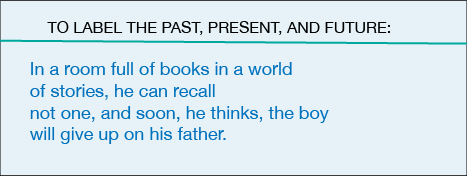
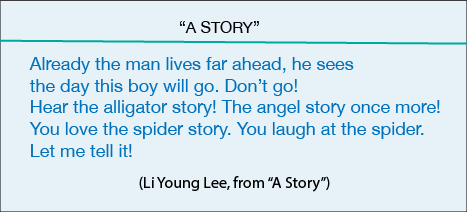
In Lee’s poem, the first stanza is delivered in the present tense and the second brings us to the future with “lives far ahead.”
To illustrate differences in location:

Indicate shifts in a poem’s mode or voice:
Stanzas can mark transitions between narrative and lyrical modes, descriptions and questions, and shifts in tone or perspective.
A shift in voice or address:
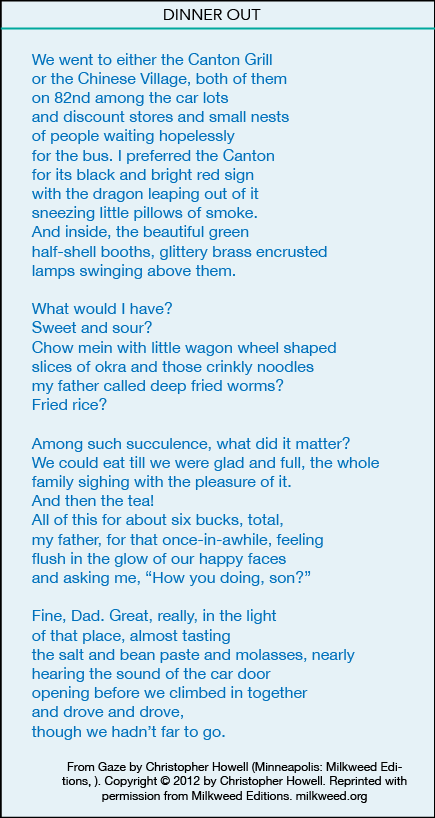
In each stanza we hear a shift in voice. The first opens in a narrative mode as we are given a place and time, a description of the street on which the restaurant the speaker and his dad go to eat. In the second stanza, the voice shifts into an interrogative mode, asking questions about what will be ordered. Though the third stanza also begins with a question, this is a different type of question than what is posed in the second stanza. Here, the voice becomes lyrical and introspective: “Among such succulence, what did it matter?” In the last stanza the voice shifts to answer the question posed by the dad in the end of the third stanza and in this way, the first line of the last stanza directly addresses the dad. In Howell’s poem each stanza is used to mark a slight shift in voice.
A shift in thought or a resolution:
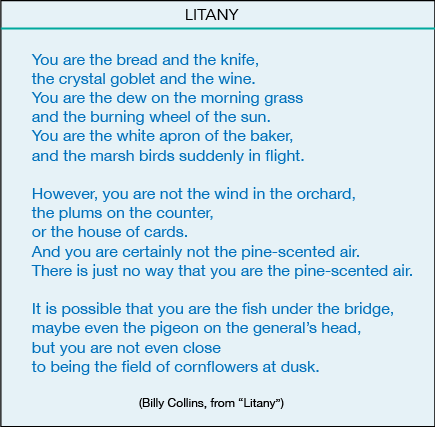
As in Howell’s poem, in Collins’ poem there is a shift in the voice’s pitch. But in “Litany,” the stanzas emphasize moves in the thought process that build upon the ideas established in the preceding stanza. You can follow these turns of thought by the transition words that begin them: “You are”…“However, you are not…” “It is possible that you are…”
Create emphasis on individual images:
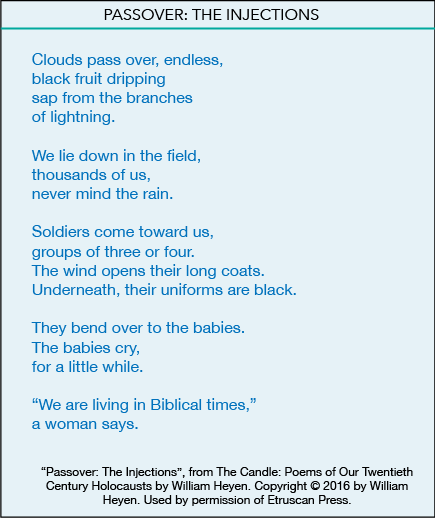
Rarely is there one reason for the way stanzas are arranged. In the above excerpt, the stanzas isolate images, but they also organize space and actions. Each stanza is end-stopped, further emphasizing the divide between the fields, the prisoners, the soldiers.
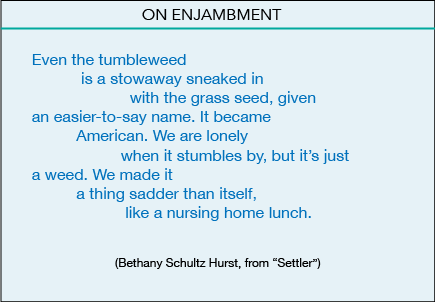
The stanzas used by Hurst accentuate the way the enjambment affects images and sounds. Each stanza break makes the line break even harder. When we end the first stanza, we are left with the idea of sharing or giving something away. There is connection: “Even the tumbleweed / is a stowaway sneaked in / with the grass seed, given.” It sounds thoughtful. It sounds like we are receiving—“given.” But moving to the second stanza, the meaning changes: “given // an easier-to-say name.” This happens again in the transition from the second to third stanzas with the meaning of “just” changing from the idea of justice or fairness—“but it’s just”—to something different: “but it’s just // a weed.” The beginning of both the second and third stanzas undercut the sentiment we are left with at the end of the preceding stanza and the way the stanzas are formed emphasize this change.
Create an image with the words on the page
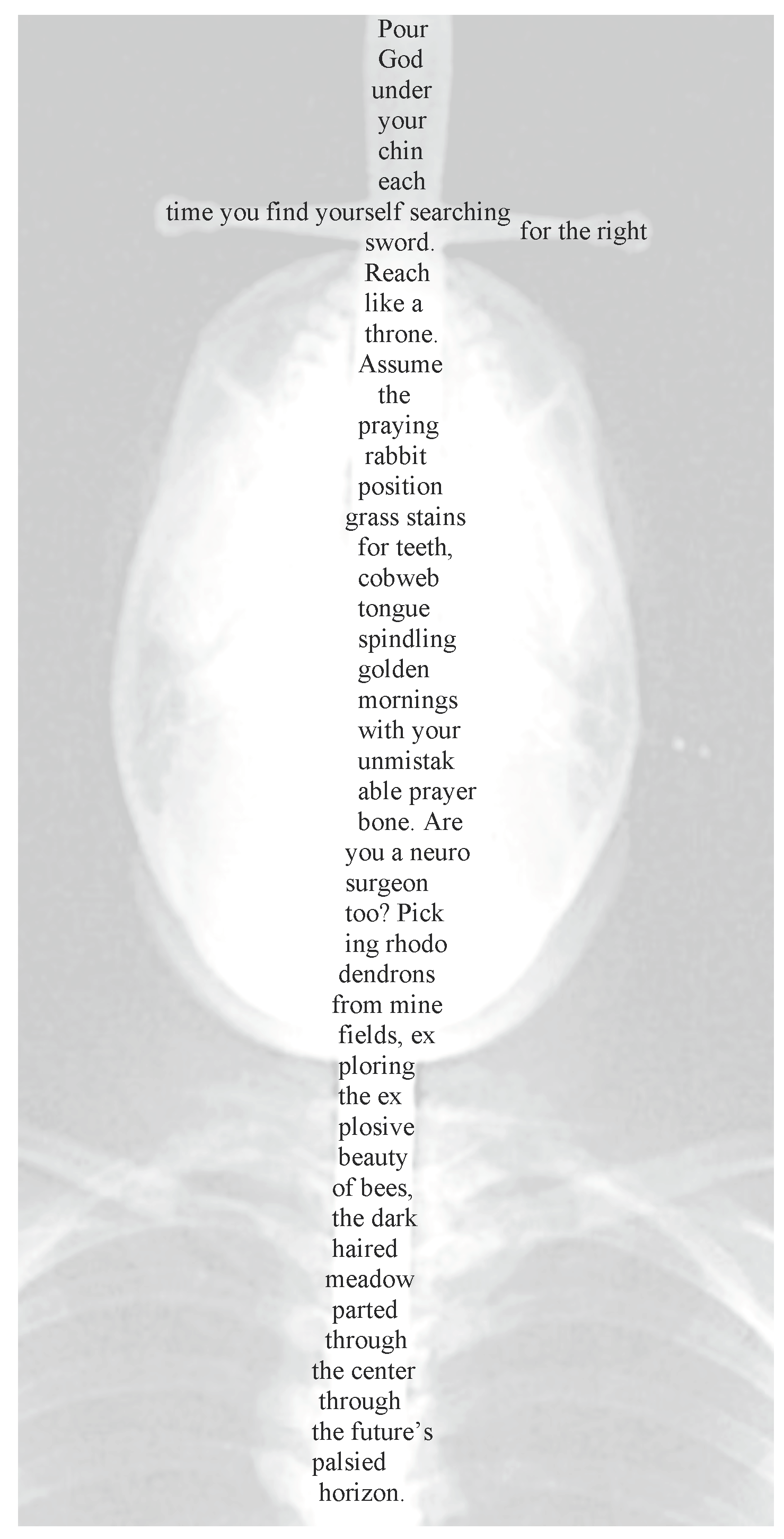
Draw attention to other patterns like repetition
In the following examples, one poem ends each stanza similarly and the other begins each stanza similarly:
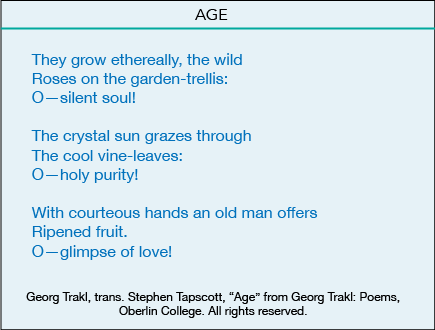
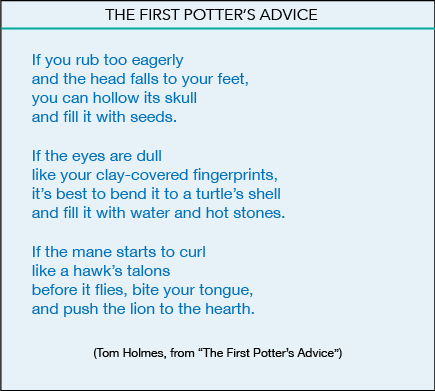
The deeper we go into the craft of poetry, the more we find elements to be connected. Stanzas cannot stand independently from choices made about music, line, and diction. Building on the components learned in this chapter, the next two chapters will introduce you to the particulars of sound and then some forms.
Additional Resources:
Pinsky, Robert. The Sounds of Poetry. http://us.macmillan.com/thesoundsofpoetry/robertpinsky
Adapted from Naming the Unnameable: An Approach to Poetry for New Generations, 2018, by Michelle Bonczek Evory, used according to creative commons CC BY-NC-SA 4.0.